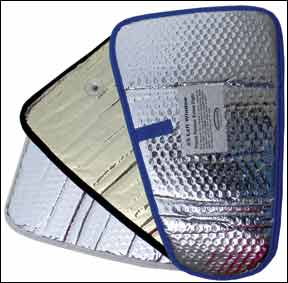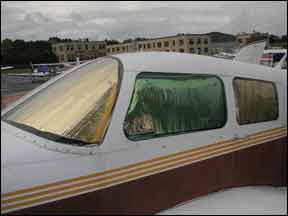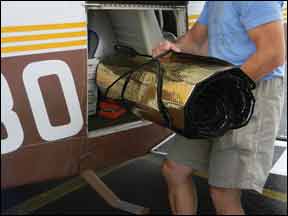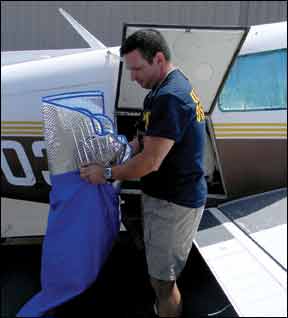Protecting your cabin and pricey electronics from damaging ultraviolet rays should be a priority. If your aircraft lives outside, chances are you’ve invested in a cabin cover, but you might not use it for short parking stays on transient ramps. Cabin window sunscreens can be a good alternative. They’ll reduce cabin heat while keeping the sun from frying avionics, cabin accessories and interior components while also deterring theft.

We judge sunscreens on three primary traits: Fit, durability and ease of storage. When they fit properly, they keep the sun out and reduce cabin heat. Good durability means they’ll continue to fit properly and stay in one piece after repeated manhandling and sloppy stowage. And, they need to be stowable with ease. All the brands we tested in this article were effective at lowering cabin temperatures while doing an adequate job of keeping damaging sun out of the cabin. But we strongly favored a couple of brands for bringing exceptional fit and build quality
DAMAGE DONE
We once learned about cabin sun damage when we parked an airplane on a South Carolina ramp for a week in August. Not only did the blazing southern sun melt the earseals on our headsets, it also finished off the gasket that retains the messy fluid inside the wet compass. Just as sun exposure is damaging to the human skin, it also does a number on aircraft cabin accessories. That includes panel and portable avionics, interior plastics and fabric. Sun exposure dries out the adhesive that’s used to secure interior components. It also dries out door seals, window gaskets and cracks the surface of the glareshield. If you leave portable electronics in the aircraft as most of us do they’ll take a beating. The good news is that modern aircraft glass is made of cell-cast, acrylic plastic that does we’ll in absorbing some UV. However, interior shops have told us that UV will fade upholstery and degrade the fabric.
Many TSO’d radios are designed to operate at around 160 degrees Fahrenheit—a temperature that might be exceeded in a sun-scorched cabin. This can compromise long-term reliability because displays, integrated circuits and other small components are at risk.
Our test aircraft was a Piper Arrow that’s parked outside and in direct shot of baking mid-summer sun. First, we measured unshielded cabin temperatures over a three-day period that happened to occur during an official heat wave with near 100-degree temperatures. We saw cabin temperatures in the 145- to 155-degree range. Installing every shield we tested reduced the temperature by at least 25 degrees.
Testing in the Piper and other aircraft models including a Cirrus and Cessna revealed that a good fit and easy installation will be difficult to achieve no matter the design of the shield. That’s because in most aircraft you’ll battle awkwardly hung wet compasses, visors, bulky glareshields, vent windows and a crammed cabin that doesn’t favor working with large shields. Speaking of crammed, storing these things in a tight baggage compartment can be easier said than done. They need to be flexible enough to fold without damaging them. All samples arrived inside drawstring storage bags.

Our testing considered the shields flexibility—the ability to bend, fold, scrunch and maneuver inside tight cabins —and especially the ease of getting them back into the storage bag. From a design standpoint, you wouldn’t want a shield to scratch your acrylic glass, so it has to be soft yet durable. We tested this carefully against the surface of the acrylic glass.
Kennon Covers
Cabin cover maker Kennon has bragging rights for developing and supplying cabin shields to military aircraft around the world. The shields are designed with a clear, polyester coating with a soft Sunbrella edge that helps prevent window scratching.
Kennon says their shields reflect 93 percent of the infrared rays back through the windows before they are absorbed and produce heat. The aluminum surface of the shields acts as a good reflector. You can easily see the sun bouncing off the surface.
The Kennon product offered the most accurate fit of any in the sample group. There was no need for suction cups or other means of fastening in the Piper and in a Cessna 206 we tested. That’s likely because these shields are computer cut. We were able to easily and quickly slap them in place on all the windows in the Piper and noted a near exact fit—something none of the other shields offered.
Our experience seems to be common. We heard favorable comments from nearly every Kennon shade user we queried. The corporate pilot of a Piper Cheyenne told us the aircraft’s Kennon shades are a valuable part of his ramp operations—and a far better alternative to draping VFR sectional charts across the glareshield to keep the sun out.
Further, he told us they do a good job of keeping the cabin heat at a minimum so that the air conditioning is more efficient once picky passengers climb aboard. They’ve also done a decent job of protecting the Cheyenne’s posh interior. A full set of shields for our Arrow cost $195.

Sun-Foil
Sun-Foil’s Aircraft Sunscreens are made from hand-rolled gold or silver-colored Mylar laminate, which the company says provides additional glass protection, rigidity and durability. We found the claim to be true. They’re also designed to reflect 97 percent of radiant heat. These shields were the thickest and most rugged in the group.
Further, they were the only ones that use a combination of suction cups and friction fit design to help keep them in place. In fact, when we tried to remove the shields in a hurry, we found the suction cups to be almost too aggressive. Where other shields wiggled and dropped slightly out of place, the Sun-Foils kept a solid grip. The shields were easy to roll together for storage and secure with a long Velcro strap.
We found them easy to drop into the storage bag that comes with a customized aircraft identification tag—a nice touch. Another nice touch was the gold coloring on the outer surface of the shields. Several ramp-dwellers commented on the shields’ good looks and we concur. Sun-Foil uses a double-stitched edging to aid in scratch protection and the company offers a lifetime guarantee on the shields workmanship. If you lose any suction cups, they’ll replace them as needed. You’ll find Sun-Foil as OEM-supplied accessories in some Cessna, Bombardier, Gulfstream and Pilatus models. A full set of shields for most singles and light twins cost between $225 and $350 for jets and turboprops.
Grow Your Own
For would-be do-it-your-selfers, Sporty’s sells sheets of insulating material sandwiched between thin sheets of aluminum. The material sells for $15.95 per yard plus Velcro mounting coins for attachment. However, this material can be damaging to acrylic windshields. Sporty’s—through Bruce’s Custom Covers—offers custom made heat shields with attaching suction cups. Bruce’s has a favorable track record with high-quality custom cabin covers. The heat shields are made from metallized polyester film and closed cell foam. We couldn’t get a custom set in time for this review, but a full set will cost around $200. If you’ve used these shields, we’d like your feedback.

Aviation Covers
Aviation Covers purchased the manufacturing rights to Cunningham Aircraft Covers in 2006. We were impressed with the Cunninghams when we tested them in our Mooney in a previous review. But not so much with the samples received this time for our Piper.
While made to obvious high standards, the shields just didn’t fit properly. The windshield pieces were too big and some of the window shades had a sloppy, oversized fit. It’s likely that our samples were made for a different application even though we specified our test aircraft by year and serial number. To be fair, we placed our order just days before AirVenture Oshkosh when most companies are scrambling. Fitment troubles aside, we found that the shields were constructed well. They are made of a foil-covered, bubble insulation material with an outer coating of clear polyester that’s intended to prevent scratching.
The edges of the shield are constructed with acrylic plastic. We liked the identification labels on the underside so you can tell which window they fit. The shields come with a drawstring bag that fought us when we tried to drop the shields inside. We just couldn’t seem to roll them tightly enough to easily fit the bag.
We spoke to the owner of a Bonanza who uses the prior Cunningham shields and he reports good fit and durability. Aviation Covers shields sell for $225.
Conclusion
Our thanks go to Total Aircraft Maintenance in Hartford, who provided the aircraft for our testing. This seasoned shop and respected interior shops we spoke with advocate use of sun shades. That’s because they’ve repaired enough sun-damaged interiors that could have been saved by sunshields or cabin covers. We think cabin covers offer the better solution because they tame water intrusion while protecting glass and antennas. But they’re heavier, bulkier and might be more time-consuming to install than shields.
Our top pick for sunshields are the Kennons. They proved to have a superior fit and passed the long-term test for overall durability. But we also like the Sun-Foil screens. We think they are handsome, have a high-quality feel and are gentle on the glass. You wouldn’t go wrong with either of the products.
Moreover, both companies were helpful and cooperative to deal with, a real plus in these days of minimal customer service.





